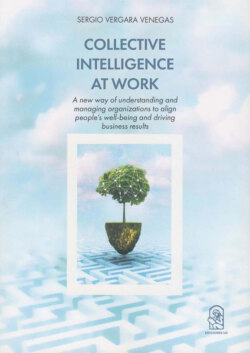Читать книгу Building Collective Intelligence in the Organization - Sergio Vergara Venegas - Страница 4
На сайте Литреса книга снята с продажи.
ОглавлениеTABLE OF CONTENTS
Prologue by Nicolás Majluf
INTRODUCTION
Collective Intelligence
Why Work on Organizational Climate?
Trying to Turn a “Soft” Topic into a “Hard” One
The Influence (and Pressure) Of Social Ranking on the Management of Organizational Climate
The Evolutionary Model of Organizational Climate
CHAPTER 1 COLLECTIVE INTELLIGENCE
Can We Learn to Be Collectively Smarter?
Key Concepts from Chapter 1
CHAPTER 2 THE ORGANIZATIONAL CLIMATE IS A RELATIONSHIP
First Principle of the Evolutionary Model: The Organizational Climate Is a Relationship
Understanding the Management of Organizational Climate as the Management of a Relationship
Organizational Climate versus Organizational Culture: What Is the Difference?
Tool 1: Self-Assessment Survey for Middle Managers and Collaborators
Key Concepts from Chapter 2
CHAPTER 3 FROM THE MOST VISIBLE TO THE LEAST VISIBLE
Second Principle of the Evolutionary Model: What Is Most Visible Is Not Necessarily the Deepest Issue
The Bottom of the Iceberg
Tool 2: Climate Contribution Index of Key Work Activities
Tool 3: Climate Contribution Map of Key Work Activities
Key Concepts from Chapter 3
CHAPTER 4 HOW EVERYONE CAN CONTRIBUTE TO ORGANIZATIONAL CLIMATE IN THEIR OWN WAY
Third Principle of the Evolutionary Model: As in Any Relationship, Managing the Organizational Climate Requires Actions from Different Roles
Senior Management Role
Middle Management Role (leaders)
Individual Role
Tool 4: The Action Plan Model for the Organizational Climate Management That Creates Maturity
Subsystems implicit in the roles
Cases of Dysfunctional Dynamics
Key Concepts from Chapter 4
CHAPTER 5 THE CONCEPT OF MATURITY IN ORGANIZATIONAL CLIMATE
Fourth Principle of the Evolutionary Model: If Relationships Mature, So Does the Organizational Climate Management
Four Stages in the Organizational Climate Management Maturity Pathway
Stage 1: Bewilderment and Frustration
Stage 2: Activism
Stage 3: Understanding
Stage 4: Managing
Key Concepts from Chapter 5
CHAPTER 6 MATURING THE ORGANIZATIONAL CLIMATE MANAGEMENT
The Levers to Make Organizational Climate Mature
Key Levers to Make Organizational Climate Management Mature (the Dos and Don’ts)
Levers between Stages 1 and 2, from “Bewilderment and Frustration” to “Activism”
Tool 5: Meeting Guidelines for Reviewing the Results of the Organizational Climate Survey
Levers Between Stages 2 and 3. From “Activism” to “Understanding”
Levers Between Level 3 and 4. From “Understanding” to “Managing”
Levers to Support Level 4 “Managing”
The Role of Human Capital Management
The Roles for Sustainable Organizational Climate Management
Structure of an Integrated Organizational Management
The Role of Managers
Tool 6: Maturity Diagnostic Instrument
Key Concepts from Chapter 6
CHAPTER 7 THE MINIMUM LEVELS IN ORGANIZATIONAL CLIMATE MANAGEMENT
Fifth Principle of the Evolutionary Model: The Hierarchical Ranking of Organizational Climate Dimensions
Key Concepts from Chapter 7
CHAPTER 8 WORK DYNAMICS AND PRACTICES
Before Changing Practices, Let’s Understand the Dynamics
Improving Practices Strengthens Dynamics
Examples of Good Practices to Improve Organizational Climate
Tool 7: Assessment Matrix of Organizational Climate Improvement Practices
Key Concepts from Chapter 8
CHAPTER 9 THE ORGANIZATIONAL CLIMATE INTERVENTION CONTROL PANEL
Why Have a Control Panel for the Organizational Climate Management Plan?
Control Panel of the Evolutionary Model of Organizational Climate Management
I. Management Model
I.1. Management Practices
I.2. Organizational Structure
I.3. Systems and Processes
I.4. Infrastructure
I.5. Compensation and Benefits
I.6. Business and Human Capital Policies
II. Culture
II.1. Implicit and Explicit Values
II.2. Group and Inter-Area Dynamics
III. Teams
III.1. Maturity of Climate Management in the Area
III.2. Climate Practices Installed
IV. Individuals
IV.1. Profile of the Critical Mass of People
IV.2. Work Maturity of the Critical Mass
Tool 8: Control Panel Checklist
From the Control Panel to the Organizational Climate Management Plan
Tool 9: Climate Maturity Management Plan
CHAPTER 10 INTERVENING WITH THE EVOLUTIONARY MODEL
EPILOGUE ORGANIZATIONAL CLIMATE AND SOCIAL MATURITY
Bibliography
